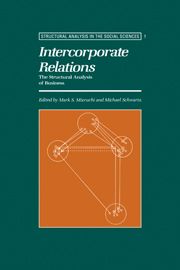The structural analysis of business: an emerging field
Published online by Cambridge University Press: 04 February 2010
Summary
As recently as the early 1970s, organizational theory was principally focussed on the internal workings of organizations, and on the analysis of internal factors as the sources of organizational behavior. The bulk of the field utilized either human relations theory, which connected internal structure to worker morale and productivity, or neo-Weberian analysis, which sought to understand the impact of internal power relations on organizational behavior. This work tended to assume unchanging organizational structures invulnerable to outside forces. Contingency theory, though it escaped the static assumptions of previous work, maintained the focus on the internal workings of the organization.
This neglect of the environmental context limited the analytic leverage of organizational theory and led to misleading and incorrect descriptions of corporate behavior. The human relations approach, for example, sought to connect managerial strategy with worker productivity, but it ignored the supply of labor in its analysis. As Pfeffer and Salancik (1978) later argued, however, scarce labor usually implies less compliant workers and more accommodating management. Human relations evaluations of the effectiveness of various managerial strategies were therefore flawed, since the outcomes of each strategy would vary depending on the supply of labor, a variable which was not addressed in their research.
There were, of course, exceptions to this general trend. Works which emphasized the context within which organizations operated included Selznick's (1949) classic study of the TVA, Thompson's (1967) seminal work on organization-environment relations, and the unorthodox contingency theory advanced by Lawrence and Lorsch (1967; see also Zald, 1970).
- Type
- Chapter
- Information
- Intercorporate RelationsThe Structural Analysis of Business, pp. 3 - 22Publisher: Cambridge University PressPrint publication year: 1988
- 6
- Cited by



